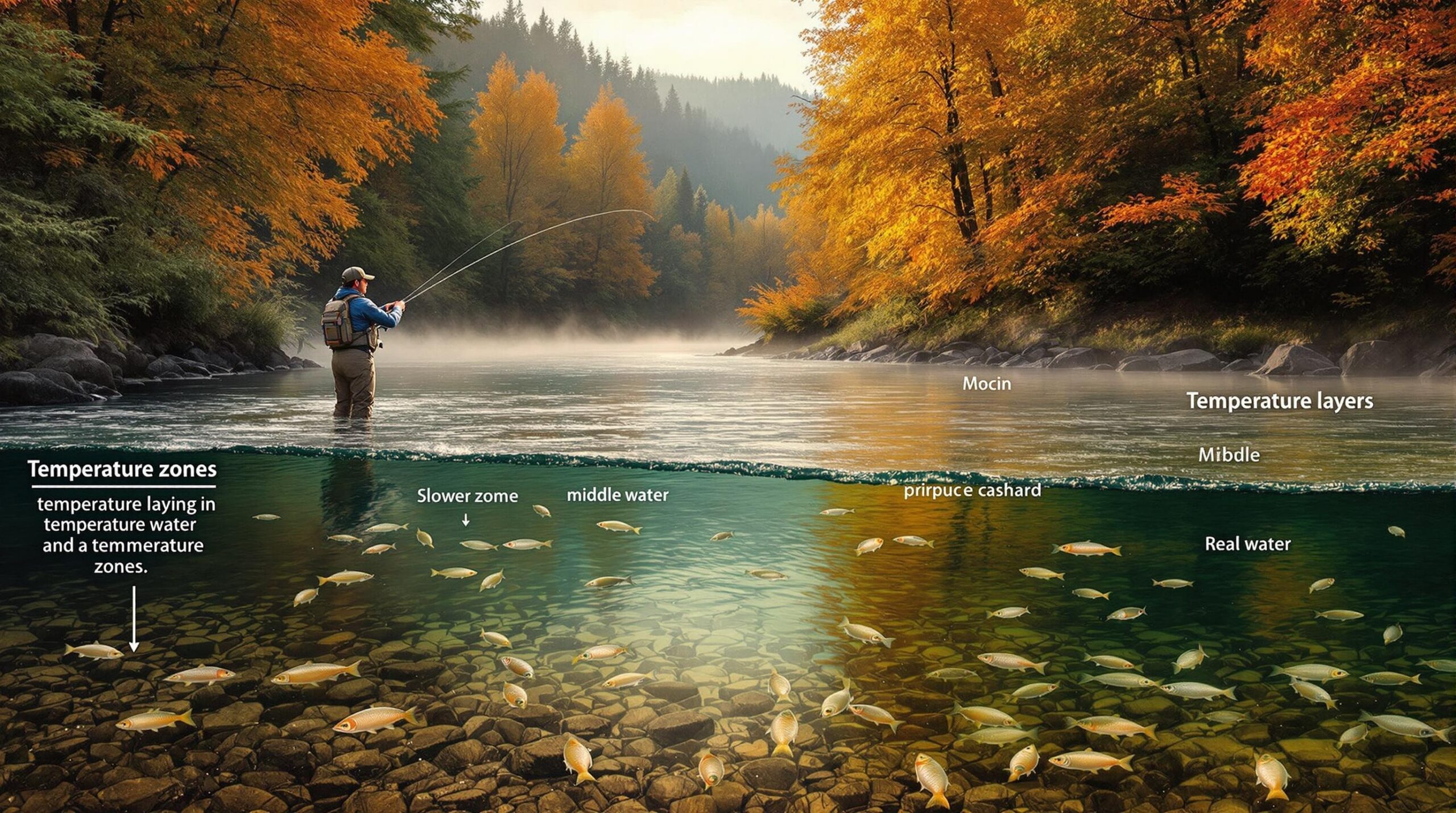Trout Habitat and Behavior
Knowing where trout hang out and how they act can give any fly fisherman an edge. Water temperature and cool, shaded areas along the water’s edge guide trout’s whereabouts.
Key Takeaways
- Trout prefer cold water between 40-60°F for optimal feeding and activity
- Riparian zones provide essential shade, cover, and food sources
- Seasonal patterns dramatically affect trout location and behavior
- Quick release and proper handling techniques are vital for trout survival
- Understanding water column positioning helps target trout more effectively
Impact of Water Temperature
Water temperature is the big boss when it comes to trout living their best lives. These finned buddies adore cold water.
| Temperature Range (°F) | Trout Behavior |
|---|---|
| Less than 40 | They get real lazy, barely snacking |
| 40-60 | Perfect temperature range, they’re busy biting and moving |
| 60-70 | They start feeling the heat, feed less, and dive down deep |
| Over 70 | Super stressed, life’s tough here |
Trout love chilling in areas that match their temperature sweet spot, perfect for munching and moving. In summer, they retreat to cooler, deeper river sections, while in winter, they prefer slightly warmer nooks like deep pools (Simpson Fly Fishing).
Role of Riparian Areas
Those forested patches next to water—riparian zones—are gold for trout. These spots are the MVP for:
- Shade: Keeps water cool, just like the trout prefer.
- Erosion Control: Plant roots keep dirt from washing into their home.
- Filter System: Plants clean up pollutants, jazzing up water quality.
- Living Space: Gives cover and a source of tasty snacks (bugs, debris).
Keeping these shaded areas fresh and vibrant is vital for a hearty trout crew. If these zones get wrecked, trout habitats can suffer from hotter temps and crummier water quality.
| Riparian Feature | Importance for Trout |
|---|---|
| Forest Cover | Throws down shade, keeps water cool |
| Root Systems | Holds soil tight, prevents erosion |
| Fallen Stuff | Gives cover, offers hidey places |
| Natural Filters | Cuts down on pollutants, boosts water purity |
Understanding these things helps anglers predict where trout chill and tweak their fishing game to match trout habits and hangouts.
Seasonal Patterns of Trout Behavior
Spring Transition
Ah, springtime! Trout are like teenagers spring cleaning their rooms – grudgingly moving from the cozy depths of their winter hideouts and getting ready to party upstream. With the water warming up, they’re on the hunt for the best spots to chow down and relax. This is a golden opportunity for those who love a good dry fly fishing session! If you’re a fan, this is the time to channel your inner fish whisperer.
| Behavior | Temperature Influence | Fishing Opportunities |
|---|---|---|
| On the move from winter hangouts | Warmer water brings the vibe | It’s dry fly season, folks! |
| Scouting for sweet spots | Food & chill vibes | Time to cast those dry flies |
Summer Movements
Summertime, and the trout are feeling… restless. These slippery critters decide it’s the season for a bit of an adventure, exploring streams like a restless traveler. They’re most active when the air is cool – think late-night frenzies and early bird shenanigans. As the sun starts blazing, they retreat back to their cool spots like kiddos avoiding chores.
| Behavior | Time of Day | Temperature Influence |
|---|---|---|
| Roaming around | Night and crack of dawn | Catch ’em while it’s cool |
| Retreating to safe spots | As the sun works its magic | Searching for that chill shade |
Fall Behavior
Autumn! A time when leaves fall and trout get a little jumpy. With streams not so full, these fish become super alert and focused on hiding from predators. Comfort takes a backseat. Fewer bites of tiny bugs mean they’ve got a thing for the little fishies now. If you’re up for the challenge, streamer fishing could be your best bet (Simpson Fly Fishing).
| Behavior | Environmental Influence | Fishing Strategy |
|---|---|---|
| Playing hide and seek | Not so much water around | Try your luck with streamer fishing |
| Hungry for miniature fish | Missing those bug snacks | Time for some nymph action |
Winter Adaptations
Winter rolls in, and trout are living life in the slow lane. With metabolism in chill mode, they’re on the lookout for warm, cozy water spots. Not up for heavy meals, they prefer easy-to-catch snacks. So, deep pools and warmer streams are like their winter lodges, perfect for catching some z’s and the occasional bite.
| Behavior | Temperature Influence | Preferred Lies |
|---|---|---|
| Chill mode on | Brrr… it’s getting cold | Snooze spots like deep pools |
| Slow motion snacking | Craving a bit of warmth | Hangouts with warmer waters |
Trout Handling Best Practices
Importance of Quick Release
Trout aren’t the toughest critters in the stream; they’re pretty delicate, actually. So the quicker you get ’em back in water, the better their survival odds. Experts stress that keeping these fish out of water for just a few seconds makes a huge difference. Hang onto them like your phone on a roller coaster—tight but not for long, and with zero air time if possible.
Here’s a snapshot of safe handling timings:
| Action | Safe Handling Time |
|---|---|
| Trout out of water | Blink and you’ll miss it |
| Remove for photo | Until the fish’s water coat starts to dry up |
Proper Fish Handling Techniques
Handle with care isn’t just for grandma’s china; it’s for trout, too. Mistreating these fish can leave them hurtin’—or worse. Here’s the lowdown on keeping ’em happy and healthy:
- Support from Below: Hold that trout like you’re catching a baby (if babies were slimy and slippery). Slide your hand under to bear its weight gently to prevent freak-outs and injury.
- No Squeeze, Please: Grabbing a trout is not like hugging someone who loves bear hugs. Easy on the grip to avoid turning their insides to mush.
- Snap It Close to Water: If you’re snapping a selfie, keep the fish hovering above the surface. Less time in the air is less risk of damage.
- Gills Are Off Limits: Fingers and gills don’t mix. Keep those digits outta there to help the little guy breathe easy.
- Stay Cool: Handle them calmly, like you’re carrying a tray of glasses—no sudden moves. Your chill could keep the trout from a mad flailing dash, which stresses them out.
Following these pointers lets anglers show some love to the trout and the sport. It’s about respect and making sure the scaly guys stick around for the next adventure.
Advanced Fishing Techniques
Figuring out advanced fishing methods can really up your game in fly fishing, especially for those wily trout. Let’s dive into getting inside the minds of these clever fish and syncing your fly patterns to what they’re up to.
Understanding Trout Holding Patterns
Trout have hangout spots they stick to, depending on things like water temperature, bug availability, and what’s on the menu. Cracking these holding patterns gives you a leg up when you’re casting that line.
Trout love “drift feeding.” This means they base their movements on water conditions, weather, and food (source). If the water gets chilly, their metabolism hits the brakes, making them move around less to keep warm. So, they shift around in the water. Picture the water split into three layers: the bottom, middle, and top.
| Water Layer | What Trout are Doing |
|---|---|
| Bottom | Lounging in slower water, chilling in the cold |
| Middle | Getting snacks in moderate currents |
| Top | Swimming in swifter currents when they’re hungry |
Trout often hang out near the bottom where it’s relaxed, especially when there’s no reason to wrestle currents for food (source). If you keep an eye on the water and spot these patterns, you’ll have more luck reeling them in.
Matching Fly Patterns to Trout Behavior
Getting your fly patterns to mimic what trout are hungry for is key. Different bug stages require different flies, and where you place them matters.
Midge Patterns
Midges are small but mighty in fly fishing talk. Getting these right can make all the difference:
- Larva Patterns: Cast deeper before the hatch kicks off.
- Pupa Patterns: Move to medium depths as things heat up.
Knowing where the trout chill in the water helps adjust your fly’s depth.
| Fly Pattern | Best Water Layer |
|---|---|
| Larva | Bottom Layer |
| Pupa | Middle Layer |
Fry Patterns
Fry patterns are just as important, especially when you’re in the market for bigger trout. They cause a bit of drama that catches trout’s attention.
Before swapping flies, tweak your setup’s depth and weight. Trout are known for coming up to grab a bite rather than diving down for one (source). Using the “wrong” fly the right way might just work better than the opposite.
When you’re equipped with these know-how advanced methods, fishing becomes less of a game of chance and more of a strategic sport. Mastering trout habits and aligning your fly tactics with their moves can seriously boost your success – and keep you out there for hours.

